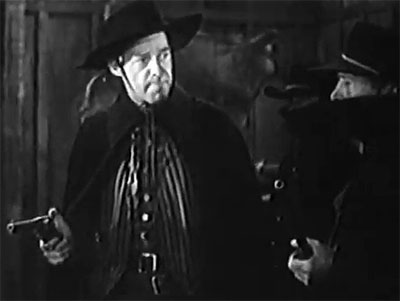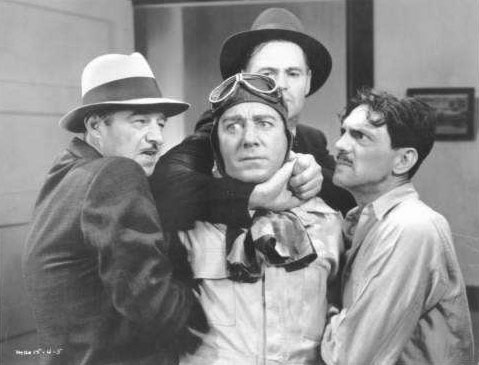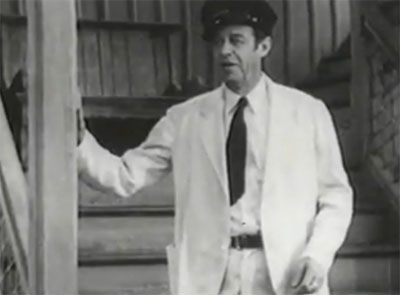February 26th, 1891 — December 27th, 1957

Above: Al Bridge in the serial Burn ‘Em Up Barnes (Mascot, 1935).
Al Bridge’s raspy, drawling voice, craftily cynical face, and general skill at playing antagonistic but colorful characters stood him in good stead throughout his career, first as a B-movie and serial heavy and then as a character player in A-films. Bridge could play hard-bitten tough guys, slickers, and furtive sneaks with equal flair, but in his serials he specialized in playing insolent, untrustworthy henchmen. Bridge’s secondary villains tended to be sarcastic, double-dealing, and pretty disrespectful of their principals; their cockiness and shiftiness often got them bumped off by the head villain at some point in the serial—but not before the smirking, snarling Bridge had stolen plenty of scenes.
Born in Philadelphia, Al Bridge worked as a newspaperman and served in World War 1 before settling down to an acting career. He attended a Kansas City drama school sometime in the early 1920s and then formed his own musical comedy company together with his sister Loie. The Bridge Players toured the US throughout the twenties, arriving in Hollywood around 1930, where both Al and Loie took up independent careers as character players. Al’s gruff voice made him a natural for heavy roles in the decade’s brand-new “talkies,” and he began his screen career as the leading villain in the independently-produced Tom Tyler B-western God’s Country and the Man (1931). For the first four or five years of his Hollywood stint, Bridge would appear in many more westerns for God’s Country producer Trem Carr, while working for additional “Poverty Row” independent producers, playing an occasional bit in an A-film—and taking major roles in several serials for a low-budgeted but energetic studio called Mascot Pictures.
In 1932, Bridge appeared in his first chapterplay, Mascot’s exciting railroad adventure The Hurricane Express. He played a stationmaster named Karlson, one of multiple characters suspected of being the mysterious railway saboteur, the Wrecker. Bridge’s main function in this serial was to act shifty and refuse to answer any questions hero John Wayne asked him; his crafty appearance suited him well in the part—but, of course, he was far too obvious a Wrecker suspect and was eventually killed off by the real Wrecker.

Above: Al Bridge sneers at off-screen fellow-suspect Matthew Betz in The Hurricane Express (Mascot, 1932).
Bridge played a more straightforwardly villainous role—outlaw Curly Bates–in his next Mascot serial, The Devil Horse (also 1932). Bates, the leading henchman to rustler boss Noah Beery Sr., was a cunning and extremely shifty character, who not only spun repeated lies to confound star Harry Carey, but double-crossed his own boss too. Bridge gave Bates a fittingly lizard-like manner, and made the villains’ smirking acts of prevarication very entertaining to watch.

Above: Al Bridge spins a lie for Sheriff Ed Peil as Noah Beery Sr. watches approvingly in The Devil Horse (Mascot, 1932).
Bridge teamed up with Beery again in Mascot’s 1933 cliffhanger Fighting With Kit Carson. Bridge was an outlaw named Reynolds, one of the field commanders of the seemingly-respectable Beery’s plundering “Mystery Riders;” his character here was as cunning (especially when framing hero John Mack Brown in the first chapter) and as treacherous as in Devil Horse. Bridge in Carson grew increasingly angry at Beery’s continual duplicity towards his own men; by Chapter Seven, he was grimly challenging Beery for the leadership of the gang. However, he was outmaneuvered by his boss and gunned down by his erstwhile colleagues.

Above: Al Bridge tries to rally the Mystery Riders to his side in Fighting With Kit Carson (Mascot, 1933).
Bridge appeared in two 1934 Mascot serials, Burn ’Em Up Barnes and Mystery Mountain. Barnes, probably the studio’s best cliffhanger, featured Bridge as Tucker, one member of a henchman pack that also included such formidable heavies as Bob Kortman, Stanley Blystone, and Francis McDonald. McDonald functioned as the primary henchman for the first half of the serial, so Bridge’s role was smaller here than in Devil Horse or Kit Carson–but he became more prominent after McDonald’s character bit the dust, and was quite noticeable even in earlier chapters; he received a chance to indulge in some typical Bridge treachery (cagily agreeing to lead his boss into a trap in exchange for his own freedom) and typical Bridge sarcasm (taunting comic sidekick Julian Rivero by mimicking the latter’s Italian accent).

Above: Al Bridge, Edward Hearn, and Francis McDonald (left to right) overpower Jack Mulhall in Burn ‘Em Up Barnes (Mascot, 1934).
In Mystery Mountain, a modern-day Western, Bridge played a rare sympathetic role—Tom Henderson, the faithful foreman of heroine Verna Hillie’s freight company. Bridge’s trustworthiness was still called into question in the serial, however, since he was one of several characters suspected of being the masked villain called the Rattler, who was trying to sabotage both the freight company and their railroad rivals. Bridge was quite likable in his against-type role, but his naturally untrustworthy appearance kept the audience guessing as to his true motives–until, as in Hurricane Express, he was cleared in rather pyrrhic fashion by being killed off.

Above: Al Bridge and Verna Hillie react to the death of Hillie’s father in Mystery Mountain (Mascot, 1934). Hal Taliaferro is behind Hillie, and Jack Rockwell is on the far right.
Bridge returned to straight villainy in Adventures of Rex and Rinty (Mascot, 1935). This cliffhanger dealt with the joint exploits of a stolen “sacred” horse (Rex) and the stray dog (Rinty) that befriended him. Bridge was Mitchell, the chief hireling of crooked polo-playing tycoon Harry Woods; acting on Woods’ orders, Bridge first stole Rex from his island home of Sujan in the first chapter, and then repeatedly tangled with Rex, Rinty, and their human friend Kane Richmond while attempting to help his boss maintain control of the horse. Bridge was characteristically crafty and smug in Rinty, whether he was being hypocritically polite to the high priest of Sujan, sneering harshly at Richmond, feigning illness preparatory to slugging an arresting forest ranger, or threatening to double-cross Woods after being berated for the potentially risky assault on the ranger (this threat earned Bridge’s character a free ticket to the morgue at the serial’s halfway mark).

Above: Al Bridge tries to avoid being chewed up by Rin Tin Tin Jr. in The Adventures of Rex and Rinty (Mascot, 1935).
Rex and Rinty was Bridge’s final Mascot serial, and one of his last Poverty Row productions; for the rest of the 1930s, he would work chiefly in the B-movies (Western and non-Western) of more upscale studios like Columbia, Republic, Harry Sherman Productions, and Universal. Almost all of Bridge’s subsequent serial work would be for the last-named studio, beginning with 1936’s Adventures of Frank Merriwell. This cliffhanger chronicled ace college athlete Merriwell’s (Don Briggs) sporting exploits as well as his search for his missing father, held prisoner by a treasure-seeking distant relation named Daggett (Bentley Hewlett). Bridge was Black, one of Daggett’s leading henchmen, who impeded Merriwell’s quest throughout the serial. Black eventually quarreled with Daggett and double-crossed him, escaping the villains’ craft in a rowboat with some stolen gold. Wounded by a colleague (who he then pushed to the sharks), Black was rescued by Merriwell’s ship, and after artfully whitewashing his own active share in Daggett’s schemes, told Frank where his father was imprisoned. The shrewd and resilient Black was very similar to the heavies Bridge had played for Mascot, and he handled the role with the same aplomb he had showed at the smaller studio.

Above: Al Bridge snarls at Bentley Hewlett (masked, right) as Dick Wessell watches in The Adventures of Frank Merriwell (Universal, 1935). Monte Montague is partially hidden behind Hewlett, Bud Osborne is in the shadows behind Bridge.
The colorful adventure serial Ace Drummond (Universal, 1936), also cast Bridge in a role that echoed some of his Mascot cliffhanger work. He was a shady archeologist named Wyckoff, who, together with his partner Fredrik Voegding, was after a mountain of jade in Mongolia. Bridge was an undisguised villain in this serial, holding professor C. Montague Shaw hostage and engaging in other shifty behavior, but he was also a “red herring,” one of the characters suspected of being the super-criminal “The Dragon.” Bridge managed to avoid elimination when Voegding was bumped off by the Dragon halfway through, but the master villain eventually nailed the slippery Wyckoff towards the end of the serial.

Above: John King watches Al Bridge and Fredrik Voegding in Ace Drummond (Universal, 1936).
Jungle Jim (Universal, 1936), an excellent and atmospheric cliffhanger, gave Bridge his best serial role as a tough but villainous jungle guide named Slade. Slade and his partner LaBat (Frank Sutton) were retained by the crooked Redmond (Bryant Washburn) to lead him to his long-lost relative Joan Redmond (Betty Jane Rhodes), who had grown up as a native tribe’s “Lion Goddess” after being shipwrecked on a jungle coast. The Redmond-Slade expedition intended to eliminate the girl so that Redmond could enjoy her inheritance, but Jungle Jim (Grant Withers) stood in their way—as did an escaped killer called the “Cobra” (Henry Brandon), although from less altruistic motives. Bridge enjoyed plenty of screen time and emerged as the co-villain of the serial, repeatedly voicing contempt for the cowardly Redmond (“the dirty rat”), and coolly bargaining with the Cobra even when a prisoner of the latter’s native followers.

Above, from left to right: Evelyn Brent, Henry Brandon, Al Bridge, Paul Sutton, and Bryant Washburn in Jungle Jim (Universal,1936).
The excellent chapterplay Wild West Days (1937) was the last Universal serial in which Bridge played a major role. As a sneaky outlaw named Steve Claggett, he obeyed the orders of the “Secret Seven,” a group of outwardly upstanding frontier citizens who controlled the rustling and claim-jumping in the town of Brimstone. Claggett figured prominently in all of the villains’ battles with hero Kentucky Wade (John Mack Brown), and was adept at sneering and prevaricating; however, the character was also much more nervous, cowardly, and indecisive than most of Bridge’s other villains. Bridge played both the typical and atypical aspects of this part well, making Claggett’s jitteriness just as believable as his nastiness.

Above: Al Bridge assertively accuses the off-camera Frank McGlynn Jr. of murdering a fellow-henchman in Wild West Days (Universal, 1937), while furtively engaging in some gun-swapping that will lend credence to the false charge.
Tim Tyler’s Luck (Universal, 1937), featured Bridge in the first chapter as a gruff jungle riverboat captain named Trowbridge; he first appeared in an unsympathetic light, trying to prevent stowaway Tim Tyler (Frank Thomas) from going upriver to look for his missing father. However, he was not so harsh as to be unsympathetic, and the viewers could feel sorry for him when he was subsequently murdered by bandits and movingly mourned by his pet chimpanzee. Such non-villainous roles would become more and more frequent for Bridge in the 1940s.

Above: Al Bridge in Tim Tyler’s Luck (Universal, 1937).
The Great Adventures of Wild Bill Hickok (1938), Bridge’s only Columbia serial, cast him as Blackie, one of the leading members of an outlaw gang called the Phantom Raiders, who seemed to run much of Kansas, Texas, and the Indian Territory, but were challenged by Bill Hickok (William Elliott). Bridge returned to hard-bitten and nasty mold for Hickok, but although he played one of the chief henchmen, he had to share screen time with a very large cast of heroes and villains, and had less to do than in his Mascot chapterplays.
By now, Bridge had established himself as a dependable heavy and character player at all the leading B-western-making studios. His feature work would become the chief focus of his career, and his remaining serial parts (all in Universal outings) tended to be one-chapter roles or brief walk-ons. Flaming Frontiers (1938), featured him in one brief scene as John Merkle, the accomplice of a claim-jumping gang of outlaws. Beleaguered miner John Archer confronted him about his activities, and Bridge tried to lie his way out of the situation before being shot by fellow henchman Charles Stevens. Buck Rogers (1939) cast Bridge as the officer in charge of futuristic dictator Killer Kane’s (Anthony Warde) “robot room,” a powerhouse staffed by mind-controlled victims of Kane’s tyranny. Bridge appeared briefly but periodically throughout the serial, making grim comments (“he looks like he was a pretty good man–when he was a man”) when new recruits were added to the robot squad, and getting turned into a robot himself by the freed ex-robots in the final chapter.

Above: Al Bridge receives Buster Crabbe (center, wearing one of the serial’s mind-control helmets) into the robot battalion in Buck Rogers (Universal, 1939).
The Phantom Creeps (1939), gave Bridge a small bit as a crooked sailor, while Winners of the West (1940) featured him in a larger role as a cavalry captain who showed up in the final chapter to arrange a peace with a tribe of Indians that had been on the warpath for much of the serial. Bridge’s final serial was The Green Hornet Strikes Again (1940), in which he played the capable captain of a cruise ship that caught fire while transporting Britt Reid (Warren Hull) from Hawaii to the USA; he appeared in the first chapter only.

Above: Al Bridge gets bad news from the engine room in The Green Hornet Strikes Again (Universal, 1940).
The 1940s found Bridge still playing some B-western heavies, but his advancing age caused him to be cast much more frequently as responsible and non-villainous types—sheriffs, heroine’s fathers, and the like. He also began to work more frequently as an A-film character actor during this decade—principally in the comedies of director Preston Sturges, who used Bridge’s crusty presence to good advantage in Sullivan’s Travels, The Palm Beach Story, Hail the Conquering Hero, and many other films. He also played a memorable bit in Frank Capra’s It’s a Wonderful Life, while continuing to pop up in many B-films, particularly at RKO Pictures (Dick Tracy’s Dilemma, The Falcon’s Alibi). By now, he was almost exclusively playing sheriffs, police detectives, or other respectable figures.
Unlike many serial performers, Bridge did little television work when that new medium arrived in the 1950s. However, he did make multiple appearances on the shows produced by Gene Autry’s “Flying A” company (The Gene Autry Show, Annie Oakley, Range Rider), playing lawmen for the most part. Now past sixty, Bridge retired in 1954, after taking one last sheriff role in a Gene Autry episode. He died in Hollywood three years later.
Al Bridge’s various serial heavies may have proved difficult for both serial heroes and serial villains to get along with, but they were highly appreciated by serial fans. During the 1930s, few serial henchmen were as fun to watch in action as Bridge’s cranky, foxy, and outrageously duplicitous characters–and the same holds true in the present day.

Above: Al Bridge gives his craven “boss” Bryant Washburn a characteristically sarcastic look in Jungle Jim (Universal, 1936).
Acknowledgements: My thanks to the Al Bridge pages at both the Old Corral and Western Clippings for biographical information.